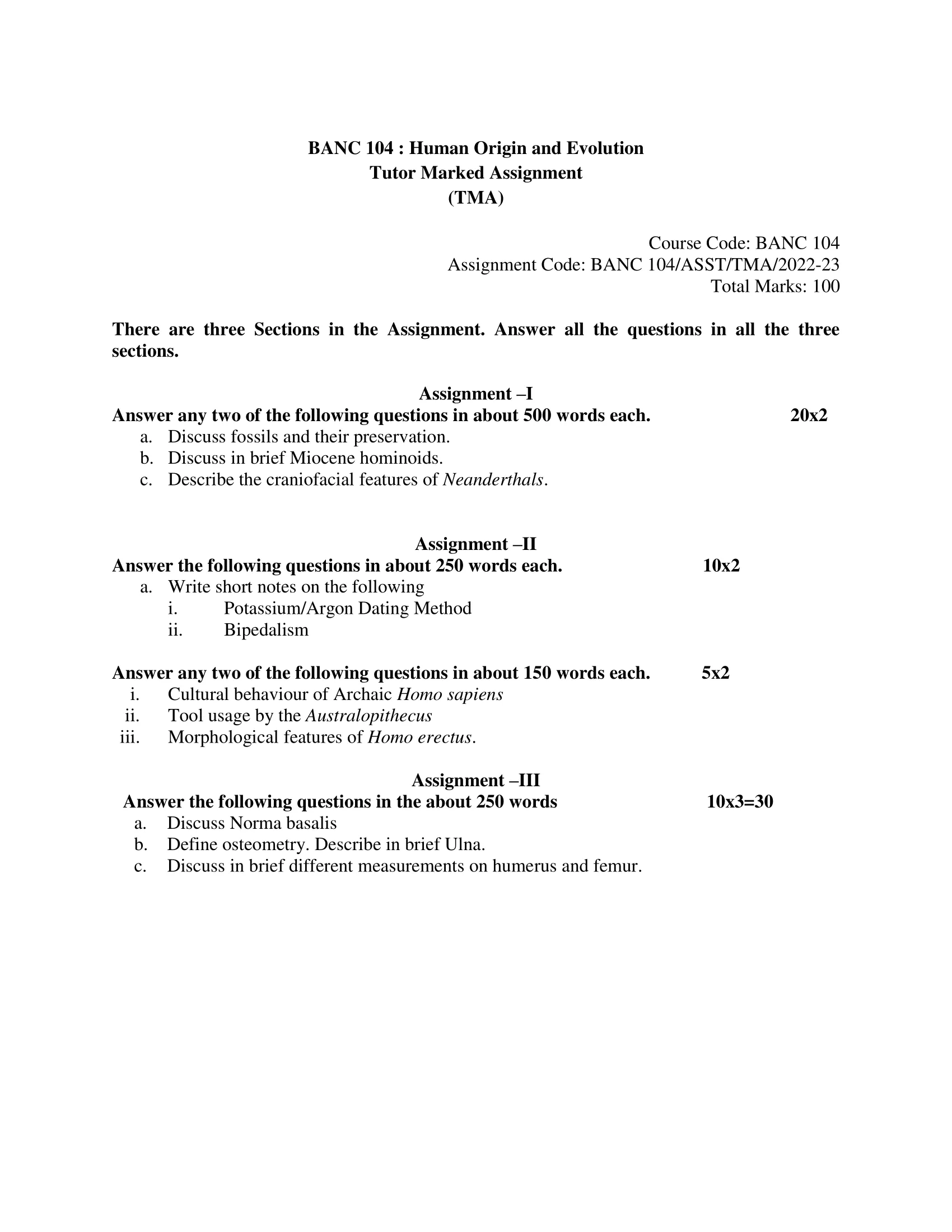Contents
- 1 Assignment –I
- 2 Answer any two of the following questions in about 500 words each. 20×2
- 3 a. Discuss fossils and their preservation.
- 4 b. Discuss in brief Miocene hominoids.
- 5 c. Describe the craniofacial features of Neanderthals.
- 6 Assignment –II
- 7 Answer the following questions in about 250 words each. 10×2
- 8 a. Write short notes on the following
- 9 i. Potassium/Argon Dating Method
- 10 ii. Bipedalism
- 11 Answer any two of the following questions in about 150 words each. 5×2
- 12 i. Cultural behaviour of Archaic Homo sapiens
- 13 ii. Tool usage by the Australopithecus
- 14 iii. Morphological features of Homo erectus.
- 15 Assignment –III
- 16 Answer the following questions in the about 250 words 10×3=30
- 17 a. Discuss Norma basalis
- 18 b. Define osteometry. Describe in brief Ulna.
- 19 c. Discuss in brief different measurements on humerus and femur.

| Title | BANC-104 |
| University | IGNOU |
| Degree | Bachelor Degree Programme |
| Course Code | BANC-104 |
| Course Name | HUMAN ORIGIN AND EVOLUTION |
| Programme Name | Bachelor of Arts (General) |
| Programme Code | BAG |
| Total Marks | 100 |
| Year | 2022-2023 |
| Language | English |
| Assignment Code | BANC 104/ASST/TMA/2022-23 |
| Last Date for Submission of Assignment: | For June Examination: 31st April For December Examination: 30th September |

Assignment –I
Answer any two of the following questions in about 500 words each. 20×2
a. Discuss fossils and their preservation.
Ans: Fossils are the remains, imprints, or traces of ancient organisms that have been preserved in rocks and sediments. They are considered important evidence of life that existed on Earth millions of years ago, providing valuable information about the history of life and the evolution of species. Fossils can be found in many forms, including bones, shells, imprints, and even fossilized feces.
Fossil preservation is a complex process that occurs over millions of years. The process begins with the death of an organism, which is usually followed by decay and destruction. However, in some cases, the remains of an organism can be buried and protected from further destruction by sediment. Over time, the sediment becomes compacted and hardens into rock, preserving the remains within.
The type of fossil that is formed depends on the type of organism and the conditions under which it was buried. For example, the hard shells of mollusks, such as clams and snails, are well-preserved in sedimentary rocks, while the softer parts of organisms, such as skin and muscle, are rarely preserved. In some cases, the remains of an organism are replaced by minerals, creating a cast or mold of the original organism. In other cases, the remains are imprinted into the sediment, creating a trace fossil.
There are several factors that influence the preservation of fossils, including the environment in which the organism lived, the type of sediment in which it was buried, and the depth and duration of burial. Fossils are best preserved in sedimentary environments that are protected from erosion, such as in areas with low relief or in deep ocean basins. Fossils are also better preserved in fine-grained sediments, such as mudstone and shale, which protect the remains from damage.
Fossils are also subject to various types of degradation over time, including weathering and physical erosion. Some fossils are also altered chemically by groundwater, which can dissolve or replace the original remains. However, the preservation of fossils can also be enhanced by chemical processes, such as mineralization, which can preserve the original tissues and structures of the organism.
b. Discuss in brief Miocene hominoids.
Ans: Miocene hominoids are a group of primates that lived during the Miocene Epoch, approximately 23 to 5 million years ago. They are believed to be the ancestors of modern-day apes and humans and include a variety of species with different adaptations and lifestyles.
One of the most important Miocene hominoids is Oreopithecus bambolii, a species of upright-walking ape that lived in Italy during the late Miocene. Oreopithecus is significant because it provides evidence of the evolution of bipedalism, which is the ability to walk on two legs. This species had adaptations in its skeletal structure, such as a long and strong pelvis, that suggest it was capable of walking on two legs.
Another important Miocene hominoid is the genus Proconsul, which was a large and heavily built species of ape that lived in what is now Kenya and Uganda. Proconsul is considered one of the earliest hominoids and is believed to have been a tree-dwelling species with a diet consisting of fruit and leaves.
Gigantopithecus is another important Miocene hominoid and is considered to be one of the largest primates to have ever lived. This species lived in Asia and is believed to have been a large, ground-dwelling species with a diet consisting of plants and possibly small animals.
c. Describe the craniofacial features of Neanderthals.
Ans: The craniofacial features of Neanderthals were distinct from those of modern humans and other hominins. Neanderthals were characterized by a number of cranial and facial adaptations that reflect their evolutionary and ecological history.
One of the most distinctive features of Neanderthal cranial anatomy was their large brow ridge, which was more pronounced than in modern humans. The brow ridge was a result of the large size of the frontal sinuses and served to provide support for the heavy muscles used in chewing and biting.
Another notable feature of Neanderthal cranial anatomy was the shape and size of their cranial vault. Neanderthals had a long and low cranial vault, which provided a larger braincase and more space for the brain. This adaptation is thought to have been an adaptation to the cold and challenging environments in which they lived.
In terms of facial anatomy, Neanderthals had a large and projecting nose, which is believed to have helped to warm and humidify the air they breathed. They also had a large and prominent mandible, or lower jaw, which was used for chewing tough and fibrous foods.
In terms of dentition, Neanderthals had large and robust teeth, which were well-suited for chewing tough and fibrous foods. They also had larger molars compared to modern humans, which reflects their adaptation to a diet that consisted of coarse and tough foods.
Finally, Neanderthals had a distinct pattern of cranial suture closure, which is the fusion of the bones that make up the skull. The cranial sutures of Neanderthals fused at an earlier age compared to modern humans, which is believed to have been an adaptation to the physical demands of their lifestyle.
Assignment –II
Answer the following questions in about 250 words each. 10×2
a. Write short notes on the following
i. Potassium/Argon Dating Method
Ans: Potassium-Argon Dating Method is a radiometric dating technique used to determine the age of rocks and minerals based on the radioactive decay of isotopes of potassium into isotopes of argon. This method is applicable to rocks and minerals that are over 100,000 years old and works best for volcanic rocks. In this method, the ratio of potassium-40 to argon-40 is used to determine the age of the rock or mineral. Potassium-40 is a radioactive isotope that decays into argon-40, with a half-life of 1.25 billion years. The age of the rock or mineral is calculated by measuring the amount of potassium-40 and argon-40 present and using the known decay rate of potassium-40.
This method has several advantages, including its accuracy, the large range of materials that can be dated, and the ability to date materials that are not well-suited for other dating methods, such as carbon-14 dating. The method is particularly useful for dating volcanic rocks and minerals, as the argon gas produced by the decay of potassium-40 is easily trapped within the solid rock or mineral.
However, the method also has some limitations, including the fact that it assumes that the rock or mineral was originally devoid of argon, which may not always be the case. In addition, the method can be complicated by the presence of excess argon, which can be introduced into the rock or mineral from surrounding minerals or from the surrounding environment.
Overall, the potassium-argon dating method is a valuable tool for geologists and archaeologists, as it provides important information about the age of rocks and minerals, which can be used to reconstruct the geological history of a region and to understand the evolution of the Earth’s crust over time.
ii. Bipedalism
Ans: Bipedalism refers to the ability of an organism to walk on two legs. It is a key characteristic of hominids, the group of primates that includes humans and their extinct ancestors. Bipedalism is believed to have evolved in early hominids over 4 million years ago, as a result of adaptations to environmental and ecological pressures, such as the need to cover large distances in search of food, or to avoid predators.
Bipedalism is a complex and highly specialized form of locomotion that requires the coordination of multiple muscle groups and the use of a number of structural adaptations, such as a larger brain, a shortened spine, and a more upright posture. Bipedalism also requires significant energy expenditure, as it requires the use of more muscles and the maintenance of a more upright posture than quadrupedal walking.
Despite its challenges, bipedalism has provided significant advantages to hominids. It has allowed them to have a better view of their surroundings, to use their hands for tool-making and other activities, and to traverse rough or uneven terrain more easily. Bipedalism has also been linked to the development of a number of other key adaptations, including the evolution of language and the development of tool use.
Today, bipedalism is a defining characteristic of humans and sets us apart from all other primates. However, it is also a source of ongoing evolutionary debate, as researchers seek to understand the exact causes and consequences of this important adaptation.
Answer any two of the following questions in about 150 words each. 5×2
i. Cultural behaviour of Archaic Homo sapiens
Ans: Cultural behavior of Archaic Homo sapiens Archaic Homo sapiens, also known as early modern humans, lived between 300,000 to 30,000 years ago and are considered the first human species to possess modern behaviors. Despite their name, Archaic Homo sapiens were not fully anatomically modern and exhibited a mix of primitive and modern traits.
Archaic Homo sapiens are known to have displayed a range of cultural behaviors, including the use of stone tools and the creation of simple weapons. They also likely had the ability to control fire and used it for warmth, cooking, and lighting. They were also capable of creating basic shelters and were likely hunters and gatherers.
In terms of social behavior, evidence suggests that Archaic Homo sapiens lived in small, closely knit groups and may have engaged in complex social relationships and possibly even trade. They may have also had the ability to create simple art, such as engravings and cave paintings, and may have used basic forms of symbolic communication, such as body adornment and the use of tools for utilitarian and non-utilitarian purposes.
Despite the many advancements made by Archaic Homo sapiens, they still had a number of primitive traits and behaviors, and it wasn’t until the emergence of Homo sapiens sapiens (anatomically modern humans) that many of the behaviors and cultural expressions seen today first appeared.
ii. Tool usage by the Australopithecus
Ans: Tool usage by the Australopithecus The Australopithecus were a group of hominids that lived in Africa between 4 and 2 million years ago and are considered to be the direct ancestors of the genus Homo. They were bipedal and had a number of adaptations for an upright posture, but their brains were much smaller than those of modern humans.
Despite their small brains, the Australopithecus are known to have used stone tools. The earliest evidence of stone tool use by Australopithecus dates back to around 2.6 million years ago, making them the first hominids to use tools. The stone tools found with their remains were simple and included hand-held cobbles and flakes, which were used for a variety of tasks, such as processing food and cutting animal hides.
The discovery of stone tools in association with Australopithecus remains has been significant in understanding the evolution of early human behavior and the development of tool use. The use of tools by the Australopithecus shows that they had the ability to manipulate their environment and suggests that they were capable of more complex behavior than previously thought.
While the tools used by the Australopithecus were simple, they were a crucial step in the evolution of human tool use, as they set the stage for more sophisticated tool-making and tool use in later human species. The development of tool use is considered to be a key factor in the evolution of the human species, as it allowed for greater efficiency and effectiveness in obtaining resources and allowed for the development of new technologies and cultural practices.
iii. Morphological features of Homo erectus.
Ans: Morphological features of Homo erectus Homo erectus is a species of early human that lived between 1.9 million and 143,000 years ago and is considered to be one of the first species of the genus Homo to have evolved. Homo erectus is known for its adaptations to a more upright and bipedal posture, which set it apart from earlier hominids and allowed it to better adapt to new environments.
One of the key morphological features of Homo erectus is its cranial anatomy. Compared to earlier hominids, Homo erectus had a larger braincase and a more vertical forehead, which is indicative of a more complex and sophisticated brain. The cranial capacity of Homo erectus was also larger than that of earlier hominids, ranging from 880 to 1,100 cubic centimeters.
Another notable feature of Homo erectus was its skeletal adaptations to a more upright and bipedal posture. Homo erectus had a more robust pelvis, longer legs, and a shortened spine, which are adaptations that allowed for efficient and stable bipedalism. Additionally, Homo erectus had a more developed ankle joint and foot bones, which allowed for better balance and stability when walking on two legs.
Other notable morphological features of Homo erectus include a more robust jaw and large molars, which are adaptations to a diet that was likely higher in tough, fibrous foods, such as roots and tubers. They also had a more projecting brow ridge and a more robust brow ridge and a more robust cranial base, which suggest a more robust cranial architecture than in earlier hominids.
Assignment –III
Answer the following questions in the about 250 words 10×3=30
a. Discuss Norma basalis
Ans: Norma basalis is a term used in anatomy to refer to a reference plane in the human body. It is also known as the basic plane or the Frankfurt plane. The norma basalis is a reference plane used to measure the orientation and position of anatomical structures, particularly in the head and neck region.
The norma basalis is defined as a plane that passes through the most posterior point of the external auditory meatus, which is the opening of the ear canal, and the midpoint of the interorbital distance, which is the distance between the two orbits of the eyes. The norma basalis is used as a reference plane to describe the position and orientation of structures in the head and neck region in a standardized manner.
This reference plane is important in anatomy and surgery because it allows for accurate measurements and descriptions of the position and orientation of structures in the head and neck. It also provides a basis for comparison between different individuals and helps to standardize measurements and descriptions in the scientific literature.
In addition, the norma basalis is used in dentistry and orthodontics to describe the position and orientation of the mandible, or lower jaw, and the maxilla, or upper jaw. It is also used to describe the position and orientation of the skull and spinal column.
b. Define osteometry. Describe in brief Ulna.
Ans: Osteometry is the study and measurement of bones in the human body. It is a subfield of anatomy that focuses on the morphological, structural, and functional aspects of bones. Osteometry involves the measurement of various parameters of bones, including their length, width, thickness, shape, and surface features.
The ulna is one of the two bones in the forearm, the other being the radius. The ulna is a long bone that runs from the elbow to the wrist, and it is located on the medial side of the forearm, opposite the radius. The ulna articulates with several bones in the upper arm, including the humerus, and with the radius at the elbow joint.
The proximal end of the ulna forms the elbow joint, and it articulates with the humerus and the radius to form a stable hinge joint that allows for the flexion and extension of the forearm. The distal end of the ulna forms the wrist joint and articulates with the bones of the wrist and hand.
The ulna is an important bone for several reasons. It provides stability and support to the forearm and wrist, and it helps to transmit forces from the upper arm to the hand. In addition, the ulna is involved in several movements of the forearm, including pronation and supination.
c. Discuss in brief different measurements on humerus and femur.
Ans: The humerus and femur are two of the largest bones in the human body and are important for movement and support. Measurements of these bones are important in anatomy, anthropology, orthopedics, and other related fields. The following are some of the key measurements on the humerus and femur:
- Humerus Length: The length of the humerus is measured from the highest point on the head of the humerus to the distal end of the bone.
- Maximum Humerus Width: The maximum width of the humerus is measured at the widest point of the bone, typically at the shaft near the midpoint.
- humerus, and it provides information about the orientation of the humerus in the shoulder joint.
- Femur Length: The length of the femur is measured from the greater trochanter, a bony prominence at the top of the femur, to the distal end of the bone at the knee joint.
- Femur Width: The width of the femur is measured at its widest point, typically at the midshaft.
- Femoral Neck Shaft Angle: This angle is formed between the shaft and the neck of the femur, and it provides information about the orientation of the femur in the hip joint.
- Intercondylar Notch Width: This is the width of the notch located at the distal end of the femur, where the bone articulates with the tibia to form the knee joint.
- Trochanteric Fossa Depth: This measurement is taken on the lateral side of the femur, near the greater trochanter, and provides information about the depth of a depression in the bone called the trochanteric fossa.
- These measurements provide important information about the size and shape of the humerus and femur and can be used to assess the health and function of these bones. For example, changes in the length or orientation of the bones can indicate diseases such as osteoporosis or arthritis, while changes in the shape of the bones can indicate developmental disorders or congenital conditions.
How to Download BANC-104 Solved Assignment?
You can download it from the www.edukar.in, they have a big database for all the IGNOU solved assignments.
Is the BANC-104 Solved Assignment Free?
Yes this is absolutely free to download the solved assignment from www.edukar.in
What is the last submission date for BANC-104 Solved Assignment?
For June Examination: 31st April, For December Examination: 30th October
















